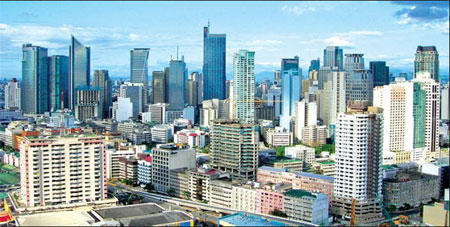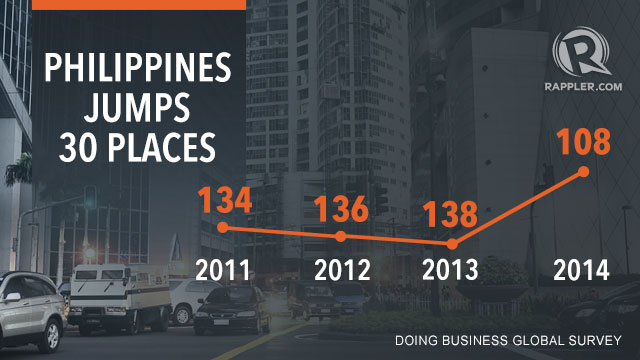The Philippines’ Fickle Fortunes
 The Philippines are perhaps not known globally as the most vibrant economy, but over the last several years it’s complete economic turnaround has sent shockwaves throughout Asia. Its current president, Benigno Aquino, has assumed office in 2010 and in mere four years has managed to lift the country from its status as a developing country to one that aspires to join the ranks of the Asian Tiger club. During his presidency (which ends in 2016), rampant corruption has been almost eradicated, government spending increased by a large amount and a sturdy, cash-rich middle class emerged. But is all as rosy as it sounds in this ASEAN country?
The Philippines are perhaps not known globally as the most vibrant economy, but over the last several years it’s complete economic turnaround has sent shockwaves throughout Asia. Its current president, Benigno Aquino, has assumed office in 2010 and in mere four years has managed to lift the country from its status as a developing country to one that aspires to join the ranks of the Asian Tiger club. During his presidency (which ends in 2016), rampant corruption has been almost eradicated, government spending increased by a large amount and a sturdy, cash-rich middle class emerged. But is all as rosy as it sounds in this ASEAN country?
The effect of Aquino’s reforms is felt most in the burgeoning middle class of the country. Philippines has one of the youngest populaces in SE Asia, with 1/3 of the country’s inhabitants just 15 years old or younger. This means that their parents are also quite young, and so the majority of the Philippines growing expendable income demographic is below 30.

That’s a bona fide middle class, something unheard-of during the days of Ferdinand Marcos regime in the 1970s or the unstable economic situation that had plagued the country later in the century. The Philippines was actually called an Asian Tiger for a brief period of prosperity in the 1990s, but it wouldn’t last — the Asian economical crisis of 1997 hit everyone very hard. In the wake of the crisis, the poverty and unemployment rates had skyrocketed, while the deep-rooted government corruption stifled any attempts to improve the situation. Fast forward 15 years and things could not be more different.

„Whoever will take office in June 2016 will inherit an economy that has less debt, more able workers, fewer dependents, low borrowing costs, and excess savings,” says Trinh Nguyen, an analyst at HSBC in a report released by HSBC Holdings plc this month, in regard to Benigno Aquino’s successful rule and the future president of the country. Clearly, Benigno Aquino’s presidency will be remembered as the turning point for Philippines and anyone to succeed him will have very large shoes to fill.

Despite shared troubled past and current prosperity, the Philippines differs from the other contemporary Asian Tigers. Its good fortunes don’t depend on cheap labour or mass production. Manufacturing contributes only 23 percent of the country’s GDP, compared to more than 34 percent elsewhere in the region. The problematic part is lack of qualified workforce. Around a million Filipinos leave the islands every year in search of work, and no new skilled tech and engineering specialists take their place. Comparative narrowing of the manufacturing sector led to smaller outside investment, possibly hampering the country’s growth. Rajiv Biswas, an economist at IHS, says that, „The economy needs a more dynamic manufacturing sector to drive the jobs’ growth that it requires, but for that the investment climate needs to improve.” In his opinion, it’s excessive red tape that makes it harder for foreign investors to enter the market.

Yet even despite these issues, the Philippines private sector is going from strength to strength. The country’s economy is growing at an astonishing rate. In 2013, the country’s GDP expanded by 7.2 percent, making it the second-fastest growing market in Asia, right after China. In May of 2014 Standard & Poor’s raised the country’s credit rating to a record-breaking BBB, expressing growing confidence in Aquina’s accomplishments. S&P’s rating change happened despite a very large unemployment and underemployment at the time and was fueled almost entirely by the country’s exemplary services and consumer spending levels.
In fact, the islands are increasingly reliant on consumer spending, which currently stands at 70 percent. A further 10 percent of the economy is due to remittances, which are experiencing another minor boom, bolstering consumer spending and overall growth. In a country dominated by consumer activity, other areas are also showing noticeable improvement — this year household consumption rose 5.2 percent, services grew 5.4 percent and industrial output gained 7.6 percent. According to Bloomberg, these past 13 quarters since the incumbent president had entered office were nothing short of miraculous for the country, as private consumption has been steadily climbing a hefty 5 percent every year.
It’s no surprise that GPD reflects these numbers, hovering around 6 percent and outpacing other neighbouring countries, whose growth fluctuates around 5. The IMF predicts similar growth at least till 2019, making the current lucky streak similar in duration and impact to the post-war economy boom experienced by the country in the 1950s.

However, dark clouds are slowly gathering on the horizon. This year marks the slowest increase in GDP growth since 2011, with economy expanding just 5.3 percent so far. In trend numbers this means a measly 0.4 percent growth for GDP quarterly. Daniel Martin, a Singaporean analyst working for Capital Economics Ltd. doesn’t see it as necessarily a bad sign. „Although the data is clearly disappointing, the Philippines is still among the fastest-growing economies in emerging Asia,” he stated, adding that there’s still hope for some increases to be expected over the next few quarters.

Another economist, Credit Suisse’s Michael Wan, thinks the decrease may be cyclical in nature, but is less optimistic about the outlook. „Currently, I’m forecasting growth of 6.3 percent in 2014, and 6 percent in 2015, but risks are to the downside,” he says. His sentiments are echoed by Eugenia Fabon Victorino at ANZ, who explains that, „With a growth average of 5.8 percent, the economy would struggle to reach even 6.0 percent for full year 2014.” Her predictions are much less positive even for 2014. „We do not expect the government to achieve its 6.5 percent-7.5 percent growth target for this year,” she says. Arsenio Balisacan, member of the Economic Planning office, is also certain that getting these numbers will be, at best, a very challenging task.
Several factors may have been contributing to the slowdown of the Filipino economy. One factor would be the Central Bank’s tightening monetary policy designed to curb the property market bubble and possible increase in inflation. The bank’s efforts concentrated around increasing interest rates, and that action didn’t go unnoticed in the region.

In response to slowing economy of the islands, Rahul Bajoria from Barclays has lowered his prognosis for the Philippines’ economical growth from 6.5 percent to 6 percent. According to him, reduced budget expenditure was the main reason behind the currently observable trend. „The largest source of the slowdown was the level of fiscal spending,” he claims, adding, „Government spending fell 2.6% year on year in the third quarter and public construction projects contracted by 6.2% in the same period.”
As Rahul Bajoria states, the country’s ailing infrastructure may be to blame here. According to HSBC survey, the Philippines rank lowest among other Southeast Asian countries as far as infrastructure quality is concerned. Problematic electrical supply grid, old rail lines and road networks are all contributing factors. Balisacan goes even as far as to say that, „The sheer lack of quality infrastructure is the single most important deterrent to investment, because it leads to high cost of doing business.”

This doesn’t look set to change any time soon. Compared to last year, this year government spending is down by 2.6 percent. Even though the government spends as much as 3.1 percent of GDP (at the beginning of 2014 it amounted to USD 9.2 bln) on projects like national roads, railways and bridge construction, its earlier plans to increase this expenditure up to 5.1 percent of GDP had been downgraded, signalling a trend of reduction in public spending.
Meanwhile, the Central Bank reacted by stating that it will pause its tightening efforts, since the interest rates hikes (of which there were two already) are more than enough to rein in inflation. Their prediction for inflation now stands at between 3 and 5 percent. Because of this and other signs of the temporary nature of the slowdown, Trinh Nguyen is still rooting for the Philippines. „Although some might despair that this is not a good number, the Philippines is still growing above trend growth rate of 5% and still very good considering the global landscape.” Let’s hope that this will indeed be the case in the coming year.
VOCABULARY
vibrant – ożywiony, tętniący życiem
turnaround – poprawa, zmiana na lepsze
to send shockwaves – odbić się (szerokim) echem, wywołać poruszenie
to assume office – objąć urząd/stanowisko
mere – ledwie, tylko
to lift sth from sth – wyciągnąć coś z czegoś
developing – rozwijający się
to aspire to do sth – mieć ambicję, żeby coś zrobić
to join the ranks – wejść do szeregów, zostać członkiem (organizacji, grupy)
presidency – urzędowanie (prezydenta)
rampant – szalejący
to eradicate – zlikwidować
government spending – wydatki budżetowe/publiczne
sturdy – mocny, solidny
cash-rich – zasobny w gotówkę
to emerge – pojawić się, zaistnieć
rosy – różowy, różowo
ASEAN (Association of Southeast Asian Nations) – Stowarzyszenie Krajów Azji Południowo-Wschodniej
burgeoning – rozwijający się, raczkujący
populace – populacja
inhabitant – mieszkaniec
majority – większość
expendable income – dochód zbywalny
demographic – warstwa demograficzna, grupa wiekowa
bona fide – autentyczny, prawdziwy
unheard-of – nieznany, niespotykany
regime – reżim
to plague sth – nękać coś
century – wiek
brief – krótki
to last – potrwać
to hit sb hard – boleśnie kogoś dotknąć
in the wake of sth – w wyniku/następstwie czegoś
poverty – ubóstwo
unemployment rate – wskaźnik bezrobocia, odsetek
to skyrocket – gwałtownie wzrosnąć
deep-rooted – głęboko zakorzeniony
to stifle sth – pohamować coś, zdusić
to improve – polepszyć, poprawić
to fast forward – przewinąć, przejść do przodu (w czasie)
to inherit – odziedziczyć
debt – zadłużenie
dependent – uzależniony
excess – nadmierny, nadwyżkowy
savings – oszczędności
to release – opublikować
plc (public limited company) – publiczna spółka akcyjna (z ograniczoną odpowiedzialnością), SA
in regard to sth – odnośnie (do) czegoś
rule – rządy, rządzenie
turning point – punkt zwrotny
to succeed sb – nastąpić po kimś, objąć urząd po kimś
to have big shoes to fill – musieć komuś dorównać, zająć miejsce kogoś (utalentowanego, osiągającego sukcesy itp.)
despite – pomimo
troubled past – niespokojna przeszłość
to differ from sth – różnić się od czegoś
contemporary – współczesny
fortunes – losy, dzieje
to depend on sth – zależeć od czegoś
labour – praca, siła robocza
manufacturing – produkcja
to contribute – przyczyniać się, wkładać
GDP (gross domestic product) – PKB (produkt krajowy brutto)
compared to sth – w porównaniu do czegoś
elsewhere – gdzie indziej
lack – brak
qualified – wykwalifikowany
workforce – siła robocza
skilled – wykwalifikowany
tech – wysokotechnologiczny
to take sb’s place – zająć miejsce kogoś
comparative – relatywny, stosunkowy
to hamper sth – przeszkadzać, utrudniać coś
to drive sth – napędzać coś, zasilać
to require – wymagać
excessive – nadmierny
red tape – biurokracja, gąszcz przepisów
to be going from strength to strength – osiągać ciągłe sukcesy
astonishing – zdumiewający
to expand – poszerzyć się, zwiększyć
second-fastest – drugi, drugi spośród najszybszych/najszybciej (rozwiających się…)
record-breaking – rekordowy
to express – wyrazić, okazać
confidence – zaufanie
accomplishment – osiągnięcie
unemployment – bezrobocie
underemployment – zatrudnianie poniżej kwalifikacji
to fuel sth – napędzać coś, zmotywować
entirely – całkowicie
exemplary – wzorowy
consumer spending – wydatki na konsumpcję
increasingly – coraz bardziej
reliant on sth – polegający na czymś, zależny od czegoś
to stand at X – wynosić X
due to – z powodu
remittances – przekazy pieniężne
minor – niewielki, pomniejszy
to bolster sth – wzmocnić coś, zwiększyć
overall – ogółem, ogólny
dominated – zdominowany, w którym dominuje
noticeable – widoczny
household – domowy, dotyczący gospodarstw domowych
industrial output – produkcja przemysłowa
according to – zgodnie z, według
incumbent – obecny, piastujący obecnie urząd
to be nothing short of X – nie być niczym innym, jak X
miraculous – cudowny, niewiarygodny
steadily – powoli i równo
hefty – pokaźny, spory
to reflect sth – odzwierciedlać coś
to hover – unosić się, tu: wahać (w okolicach)
to outpace sth – przebijać coś, być szybszym niż coś
to fluctuate – wahać się
the IMF (International Monetary Fund) – MWF (Międzynarodowy Fundusz Walutowy)
to predict – przewidywać
lucky streak – pasmo sukcesów, szczęśliwa passa
duration – długość, czas trwania
impact – wpływ
to gather – zbierać się
to mark – znamionować, oznaczać
measly – mizerny
bad sign – zły objaw/omen
disappointing – rozczarowujący
to expect – spodziewać się, oczekiwać
cyclical – cykliczny
outlook – perspektywa (czasowa)
to forecast – prognozować
downside – tu: zniżkowy, obniżający się
sentiment – pogląd, opinia
to echo sth – powtarzać coś, podzielać (opinię)
average – średnia
to struggle to do sth – borykać się ze zrobieniem czegoś
to reach – osiągnąć, sięgnąć
prediction – prognoza, przewidywanie
to achieve – osiągnąć, zdobyć
challenging – trudny, pełen wyzwań
to contribute to sth – przyczyniać się do czegoś
slowdown – spowolnienie
to tighten sth – ograniczyć coś, zaostrzyć
to curb sth – ograniczyć coś, pohamować
property market – rynek nieruchomości
bubble – bąbel, niestabilny boom ekonomiczny
interest rate – stopa procentowa
unnoticed – niedostrzeżony, przegapiony
response – odpowiedź, reakcja
prognosis – prognoza
expenditure – wydatki, nakłady
observable – dostrzegalny
fiscal – tu: budżetowy
to claim – twierdzić
to contract – skurczyć się, zmniejszyć
ailing – niedomagający, w kiepskim stanie
to blame – obwiniać, obarczać winą
survey – sondaż, ankieta
to rank – plasować się (w rankingu), być na miejscu
as far as sth is concerned – w zakresie czegoś, jeśli chodzi o coś
supply – dostawa, zaopatrywanie
grid – sieć (energetyczna)
rail – kolej
to go as/so far as to say… – posunąć się wręcz do stwierdzenia, że…
sheer – sam w sobie
deterrent to sth – czynnik/element odstraszający coś, powstrzymujący
to amount to X – wynieść X
to downgrade – obniżyć
to signal sth – zasygnalizować coś
to pause sth – wstrzymać coś
hike – podwyżka
to rein sth in – pohamować coś, okiełznać
temporary – tymczasowy, chwilowy
to root for sb – kibicować komuś, być dobrej myśli jeśli chodzi o kogoś
to despair – tracić nadzieję
considering sth – zważywszy na coś
landscape – krajobraz
by Prochor Aniszczuk







